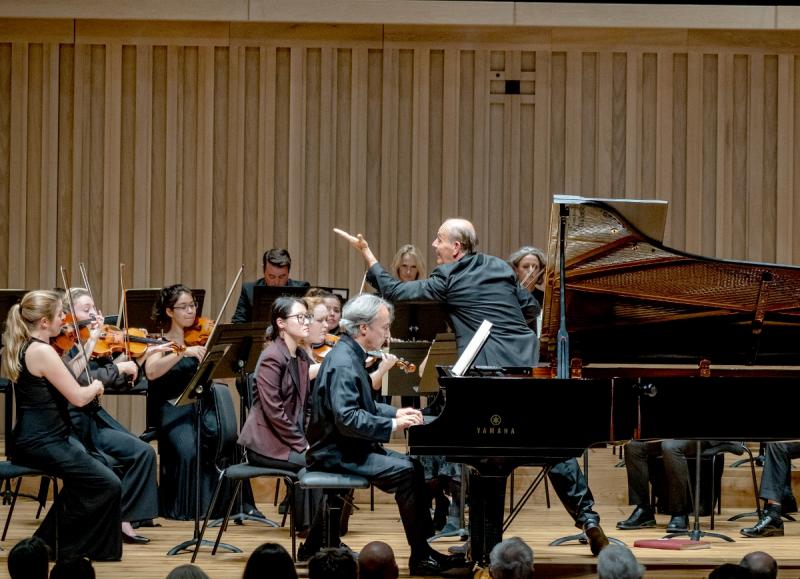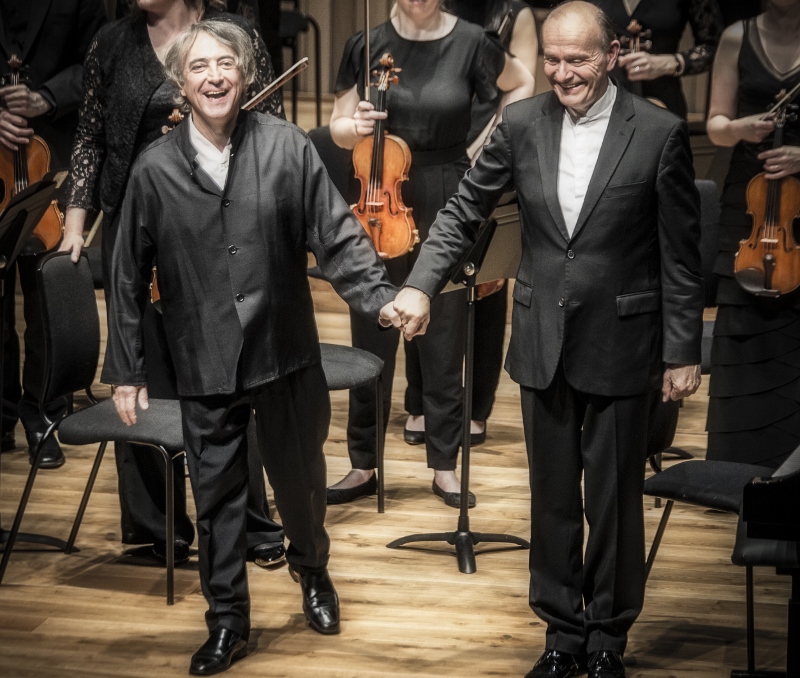Bavouzet, Manchester Camerata, Takács-Nagy, Stoller Hall, Manchester review - together again | reviews, news & interviews
Bavouzet, Manchester Camerata, Takács-Nagy, Stoller Hall, Manchester review - together again
Bavouzet, Manchester Camerata, Takács-Nagy, Stoller Hall, Manchester review - together again
A great partnership returns to public Mozart recording project

The joint enterprise of soloist Jean-Efflam Bavouzet and conductor Gábor Takács-Nagy, with Manchester Camerata, in recording publicly all Mozart’s piano concertos alongside his opera overtures – with the project theme “Mozart, made in Manchester” – was rudely interrupted after 2019 by you-know-what.
Last night they were all back together at Chetham’s School of Music, and it was just like they’d never been gone. The concertos on the order paper were Nos. 22 and 23: the latter in A major a great favourite for its sunny, optimistic beginning and end, the former, in C minor, possibly a greater work all round and certainly tinged with a depth of misery in its slow movement that became the peak of emotional intensity of the whole concert.
The project includes opera overtures because, in Gábor Takács-Nagy’s words, the concertos “are also mini-operas”, and this time they began with that to Der Schauspieldirektor. Not often seen and heard on stage, the opera’s warm-up is lightweight enough, but Takács-Nagy drew big tone from the Camerata in its portentous opening and let the music then morph into bonhomie.
With around 20 strings, it was a relatively rich chamber orchestra sound, particularly in this acoustic – to be counterbalanced by the clear and powerful tone that Bavouzet obtains from his Yamaha grand.
Concerto No. 22 is a virtuosic one, but he didn’t play to the gallery (except in a physical sense, as he acknowledged their presence in every call when the applause came), taking the piano’s role into the background when it was better for the wind soloists to star. The tempo of the first movement was a well-judged relaxed allegro, allowing for gracefulness as well as pointed phrasing and energetic emphases (which Takács-Nagy likes to have – as he’s said before, recordings need them, I guess because the process tends to smooth our dynamic variation).
 In fact there is always a fascinating meeting of minds when this conductor and soloist (pictured above, acknowledging applause) work together on Mozart, and their approach to the slow movement (with the muted strings, led by Caroline Pether, playing their part) created an atmosphere of foreboding, almost that of mourning. The winds’ episode became a kind of benighted serenade.
In fact there is always a fascinating meeting of minds when this conductor and soloist (pictured above, acknowledging applause) work together on Mozart, and their approach to the slow movement (with the muted strings, led by Caroline Pether, playing their part) created an atmosphere of foreboding, almost that of mourning. The winds’ episode became a kind of benighted serenade.
The finale begins as a rustic jig, but Bavouzet brought invention and embellishment in bucketloads to it, especially in its Andante cantabile interlude. His cadenzas, d’après Hummel, in both opening and finale added a sprinkling of harmonic spice to the fire in his fingers.
One thing I like about Takács-Nagy’s readings (using his own characteristically colour-coded scores) is his attention to the flavours of Mozart’s closing themes. No two are ever alike, and that was true of Concerto No. 23 as much as No. 22. The piece is full of tunes, but there’s much more to it than that, as Bavouzet’s extrovert playing of the first movement cadenza (echt-Mozart) and its final tutti, showed, and the dialogue effect that followed the central movement’s gorgeous solo opening, with its Neapolitan-inflected harmony, was a thing of real beauty. The Allegro assai finale was a romp, with fun had by all and Bavouzet tapping his feet into it by the final reprise.
The same fast finish was found in the last movement (another Allegro assai) of the Symphony No. 40, which completed the concert programme. Most of the orchestra stood throughout to play it, and far from being just another run-through it touched depths of emotional agony rarely attained by interpreters. Takács-Nagy sees the minuet as a dance of grim determination but with a vivid burst of sunlight in its trio, and the finale’s fury also had its spasms of melancholy and regret.
rating
Explore topics
Share this article
The future of Arts Journalism
You can stop theartsdesk.com closing!
We urgently need financing to survive. Our fundraising drive has thus far raised £49,000 but we need to reach £100,000 or we will be forced to close. Please contribute here: https://gofund.me/c3f6033d
And if you can forward this information to anyone who might assist, we’d be grateful.

Subscribe to theartsdesk.com
Thank you for continuing to read our work on theartsdesk.com. For unlimited access to every article in its entirety, including our archive of more than 15,000 pieces, we're asking for £5 per month or £40 per year. We feel it's a very good deal, and hope you do too.
To take a subscription now simply click here.
And if you're looking for that extra gift for a friend or family member, why not treat them to a theartsdesk.com gift subscription?
more Classical music
 Hallé John Adams festival, Bridgewater Hall / RNCM, Manchester review - standing ovations for today's music
From 1980 to 2025 with the West Coast’s pied piper and his eager following
Hallé John Adams festival, Bridgewater Hall / RNCM, Manchester review - standing ovations for today's music
From 1980 to 2025 with the West Coast’s pied piper and his eager following
 Kaploukhii, Greenwich Chamber Orchestra, Cutts, St James's Piccadilly review - promising young pianist
A robust and assertive Beethoven concerto suggests a player to follow
Kaploukhii, Greenwich Chamber Orchestra, Cutts, St James's Piccadilly review - promising young pianist
A robust and assertive Beethoven concerto suggests a player to follow
 Robin Holloway: Music's Odyssey review - lessons in composition
Broad and idiosyncratic survey of classical music is insightful but slightly indigestible
Robin Holloway: Music's Odyssey review - lessons in composition
Broad and idiosyncratic survey of classical music is insightful but slightly indigestible
 Classical CDs: Wolf-pelts, clowns and social realism
British ballet scores, 19th century cello works and contemporary piano etudes
Classical CDs: Wolf-pelts, clowns and social realism
British ballet scores, 19th century cello works and contemporary piano etudes
 Bizet in 150th anniversary year: rich and rare French offerings from Palazzetto Bru Zane
Specialists in French romantic music unveil a treasure trove both live and on disc
Bizet in 150th anniversary year: rich and rare French offerings from Palazzetto Bru Zane
Specialists in French romantic music unveil a treasure trove both live and on disc
 Scottish Chamber Orchestra, Ibragimova, Queen’s Hall, Edinburgh review - rarities, novelties and drumrolls
A pity the SCO didn't pick a better showcase for a shining guest artist
Scottish Chamber Orchestra, Ibragimova, Queen’s Hall, Edinburgh review - rarities, novelties and drumrolls
A pity the SCO didn't pick a better showcase for a shining guest artist
 Kilsby, Parkes, Sinfonia of London, Wilson, Barbican review - string things zing and sing in expert hands
British masterpieces for strings plus other-worldly tenor and horn - and a muscular rarity
Kilsby, Parkes, Sinfonia of London, Wilson, Barbican review - string things zing and sing in expert hands
British masterpieces for strings plus other-worldly tenor and horn - and a muscular rarity
 From Historical to Hip-Hop, Classically Black Music Festival, Kings Place review - a cluster of impressive stars for the future
From quasi-Mozartian elegance to the gritty humour of a kitchen inspection
From Historical to Hip-Hop, Classically Black Music Festival, Kings Place review - a cluster of impressive stars for the future
From quasi-Mozartian elegance to the gritty humour of a kitchen inspection
 Shibe, LSO, Adès, Barbican review - gaudy and glorious new music alongside serene Sibelius
Adès’s passion makes persuasive case for the music he loves, both new and old
Shibe, LSO, Adès, Barbican review - gaudy and glorious new music alongside serene Sibelius
Adès’s passion makes persuasive case for the music he loves, both new and old
 Anja Mittermüller, Richard Fu, Wigmore Hall review - a glorious hall debut
The Austrian mezzo shines - at the age of 22
Anja Mittermüller, Richard Fu, Wigmore Hall review - a glorious hall debut
The Austrian mezzo shines - at the age of 22
 First Person: clarinettist Oliver Pashley on the new horizons of The Hermes Experiment's latest album
Compositions by members of this unusual quartet feature for the first time
First Person: clarinettist Oliver Pashley on the new horizons of The Hermes Experiment's latest album
Compositions by members of this unusual quartet feature for the first time

Add comment